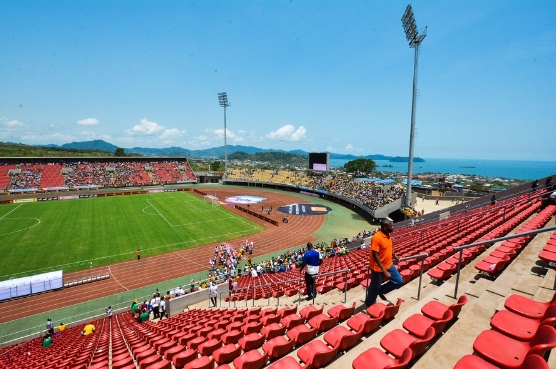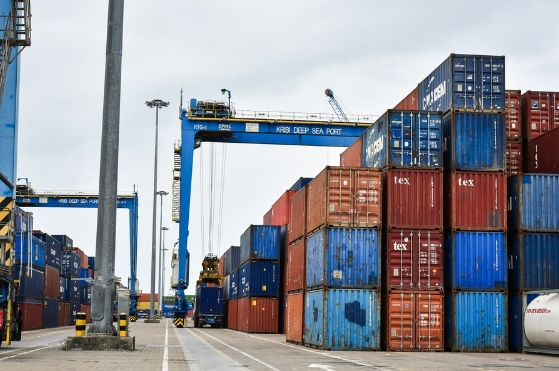China's Belt and Road Initiative paves way for common prosperity in Central Africa

This photo taken on March 26, 2016 shows a view at Limbe Omnisport Stadium in Cameroon. (Photo by Kepseu/Xinhua)
Central African leaders met Saturday in Bangui, the capital of the Central African Republic, to celebrate the 30th anniversary of the Central African Economic and Monetary Community (CEMAC), a regional bloc, in hopes of highlighting past achievements and defining a roadmap for strengthening regional integration, while focusing on economic challenges and growth opportunities.
Central African leaders met Saturday in Bangui, the capital of the Central African Republic, to celebrate the 30th anniversary of the Central African Economic and Monetary Community (CEMAC), a regional bloc, in hopes of highlighting past achievements and defining a roadmap for strengthening regional integration, while focusing on economic challenges and growth opportunities.
When CEMAC was created in 1994, its members -- Cameroon, Gabon, Equatorial Guinea, Central African Republic, Republic of Congo and Chad -- aimed to enhance economic development through regional integration. Saturday's event also offered the leaders an opportunity to consider how regional integration and development can be achieved under the China-proposed Belt and Road Initiative (BRI).
Since its launch in 2013, the BRI has been welcomed by all CEMAC countries as a model for cooperation with China in infrastructure development and socioeconomic transformation, said Elvis Ngolle Ngolle, international relations expert and former cabinet member of the Cameroonian government.
"Once you arrive in the CEMAC sub-region, you will see plenty of Chinese company investment projects," said Ngolle.
ROADS TO PROSPERITY
Thanks in large part to Chinese investments and expertise, CEMAC states have been blessed with the construction of some major mega-infrastructure projects in the transport sector.
A good example is the Kribi Deep Sea Port, built by China Harbor Engineering Company Ltd (CHEC) in Cameroon's southern town of Kribi. While the new seaport, which is strategically positioned in the center of the Gulf of Guinea, has stimulated the country's economy, it has become a regional hub for the African Atlantic coast.
"With the coming of the Kribi port, Cameroon has once again placed herself as the port entry to the sub-region. This (the port) has added more value to certain industrial projects in Chad, the Central African Republic and Congo," said Alain Patrick Mpila Ayissi, manager of the Land Development and Environment Department of the Port Authority of Kribi.
Currently, CHEC is busy constructing the Kribi Deep Seaport Phase II. After the completion of the project, it is expected to become a large container transit port and comprehensive hub port in Central and West Africa.
As part of the project, CHEC also constructed the Kribi-Lolabe highway that will cater to the requirements of the port transportation and logistics and make a contribution to local prosperity just like the road linking Cameroon to Congo.
The Cameroon-Congo road, constructed by contractors including Sinohydro, a Chinese civil engineering construction company, stretches 1,600 km from Yaounde, the capital of Cameroon, to Brazzaville, the Congolese capital. It has been nicknamed the "road of regional integration" by authorities.
James Essomba, who has been selling merchandise in the border town of Ntam, Cameroon's East Region, said that the new road is a game changer.
"At first, it was difficult to get goods from Congo. Now, both countries that have long traded with others outside the sub-region are trading with each other. We have seen a remarkable increase in trade and profit," said the 65-year-old.

This photo taken on March 15, 2022 shows a view of the Kribi Deep Sea Port in Kribi, Cameroon. (Photo by Kepseu/Xinhua)
CLEAN WATER AND ENERGY
Laurence Wandji, 41, is a primary school teacher in Bafoussam, Cameroon's third-largest city. A big water tower stands just a few meters from Wandji's home. The tower was contracted to the Chinese construction company CGCOC Group. In 2014, CGCOC Group arrived and set out to construct a water treatment plant and related facilities that could produce 10,000 cubic meters of water daily in the city. It was part of a project to provide water to nine cities in Cameroon.
Currently, residents can enjoy a round-the-clock water supply thanks to the project.
"We can now take good showers even in dry season thanks to China," said Wandji. "We can easily manage our daily activities which require water. Children no longer trek long distances to fetch water."
China has emerged as a collaborator in furthering CEMAC energy generation goals too. The sub-region struggles with low energy generation and high tariff costs. Constructed by Sinohydro, Memve'ele Hydroelectric Power Station, a 211-megawatt hydroelectric power station in the Ntem Valley locality in Cameroon's South Region, could offer a sustainable solution.
"Once the dam is fully operational, the problem of electricity will be greatly reduced. It is also capable of supplying electricity to neighboring countries in CEMAC because of the strong flow of the river," said Augustine Mbah, an energy consultant.
FOOTBALL (SOCCER) UNITES
Every weekend, mammoth crowds gather at Limbe Omnisport Stadium and Bafoussam Omnisport Stadium in Cameroon to watch local league matches. Constructed by China Machinery Engineering Corporation, the stadiums have become a veritable unifier for young people in the sub-region.
"Those stadiums hosted very important matches when Cameroon hosted the Africa Cup of Nations and Under-17 Central African football tournament. They build links among youth from countries through football. They are extremely useful and we are grateful to China," said James Ndukong, a football analyst.
Critics, however, allege that China's BRI projects in the CEMAC zone are a "debt trap." Analysts insist China's investment is giving a much-needed boost to the economies of the countries otherwise largely ignored by Western investors.
"Unlike other countries, China is working to help Africa restore infrastructures that are essential for economic recovery. The projects also provide massive job opportunities for local residents," said Ngolle, the international relations expert and former cabinet member of the Cameroonian government.
Reacting to "debt trap" allegations, Cameroon's Prime Minister Joseph Dion Ngute said that Cameroon is a sovereign country conscious of its responsibilities and choices.
"We are not going to listen to all kinds of snide remarks by people who think they know better. We have a country we have to develop and that is our responsibility," said Ngute while visiting the construction site of a China-funded water plant in Yaounde, the Cameroonian capital.
Xu Huajiang, general manager of China Harbor Central Africa Division which designed and constructed some major projects in Cameroon including the Kribi Deep Seaport and Kribi-Lolabe Highway, said that globalization and regionalization have become a general trend of development and should be embraced by African countries.
"It is necessary to strengthen the 'hard connectivity' of infrastructure and 'soft connectivity' of system rules and promote the four-in-one interconnection of land, sea, sky, and network," Xu said.
Editor:伏娅敏
